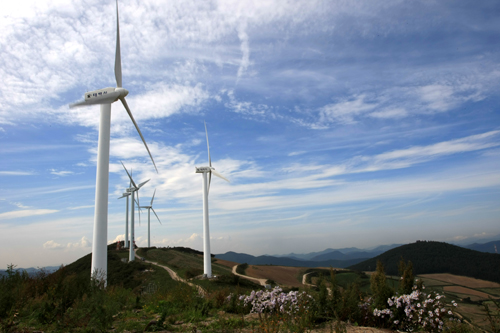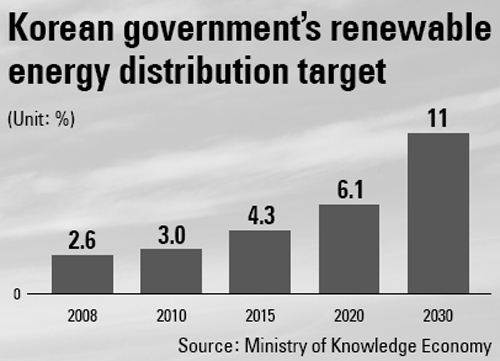What is renewable energy?

Events such as the United National Climate Change Conference in Copenhagen in December and countless other exhibitions, conventions and forums around the world have intensified the focus on preserving the environment and conserving our natural resources.
In Korea, “green growth” policies became a priority for the administration of President Lee Myung-bak after it launched its Green New Deal program last year. The Green New Deal is a road map for reviving the economy and creating jobs under the umbrella of environmental protection.
Korea has been pursuing these policies through the production of goods such as food, beverages, cosmetics and diapers and the development of technology, transportation, housing systems and business strategies. For example, companies like Renault Samsung Motors are building factories with solar panels on their roofs. There are wind power generators in Gangwon and Jeju that have also become tourist attractions.

Korea is currently one of the top nine carbon dioxide-emitting countries. It is also the world’s fourth largest importer of crude oil and the world’s seventh largest oil consumer.
Carbon dioxide is one of many greenhouse gasses that are believed to cause global warming.
Major Korean companies that emit carbon dioxide in large quantities, such as Posco or Korea Electric Power Corp., need to find ways to reduce their carbon dioxide emissions, Yang said. Otherwise, he said, Korea could face disadvantages such as trade restrictions when it does business with other countries.
In addition, Korea imports many of its energy resources, which makes it reliant upon other countries for its energy needs.
These factors make renewable energy even more important for Korea. If the country can develop ways to produce and distribute renewable energy, it won’t need to import so many raw materials from other countries and it will be able to decrease the amount of greenhouse gases it produces.
That means Korea needs to replace fossil fuels such as coal with renewable energy.
Renewable energy is energy generated from natural sources such as the sun, wind and water that are unlimited and do not pollute the environment.
Yang believes that Korean companies should move quickly to acquire or develop the technology needed to produce alternative sources of energy.
In recent years, Korea has been working to develop renewable energy sources. But the use of solar and wind power, for example, is still low compared to other advanced countries. Last year Korea’s distribution of renewable energy only accounted for 2.6 percent of its overall energy supply. The government is hoping to increase the distribution rate to 11 percent in 2030 as part of its Green New Deal.
However, the biggest obstacle to using renewable energy is still the cost of the initial investment. This prevents many countries from using more renewable energy because fossil fuels are still less expensive.
In Korea, the fundamental technology needed to generate and distribute solar, wind and water power still needs to be imported here from abroad.
To develop new technology that can support renewable energy, the Korean government will raise 111.5 trillion won through 2030. The government will spend 39.2 trillion won, and the rest of the money will come from the private sector.
The most popular form of renewable energy is solar power.
Many countries around the world started developing solar energy technologies after a dispute over oil decreased oil supplies in the early 1970s. That incident raised awareness around the world about the reliance on fossil fuels from the Middle East.
This prompted major countries including the U.S., Japan and Germany to open research centers and solar power plants.
But the excitement about solar energy began to decrease after oil prices stabilized in the early 1980s and consumers and companies went back to using fossil fuels.
Interest in solar energy returned in the 2000s when scientists again began raising awareness to the relationship between fossil fuels and global warming.
In Korea, solar power is a popular energy source. Companies here have been working to develop solar power since the 2000s. The focus was especially great in 2008, after oil prices shot up to an all-time high.
Today, the market for solar energy in Korea is growing at an alarming rate of between 30 and 40 percent every year.
The first commercial solar energy plant in the nation was built in late 2008 in Sinan, South Jeolla. It is the largest solar power plant in the country and can generate 24 megawatts of electricity in a year.
Wind power is another popular source of renewable energy here.
Although the amount of energy generated by wind power accounts for less than 1 percent of all the energy generated in the world, wind power has the potential to generate more than 16 percent of the world’s energy in 2020 and 34 percent in 2050.
A wind power generator is less complicated to set up than a solar power generator. However, the biggest flaw of the wind power generator is that it is dependant on the speed and direction of the wind, which is less predictable than the sun.
The wind power farm in Gangwon Province is the largest in Korea. It can generate 98 megawatts of energy in a single year. The government is also setting up a wind power farm on Jeju Island.
Another renewable energy source the government is experimenting with is tidal energy. This energy source comes from the power of ocean waves.
A tidal power plant is currently being built on Lake Sihwa on the country’s west coast. It is scheduled for completion next year. The tidal plant is the largest of its kind in the world and can generate 254 megawatts of power.
When the plant is complete, the amount of energy it can produce will be equivalent to 862,000 barrels of crude oil imported from overseas. The plant will reduce the nation’s carbon dioxide emissions by 315,000 tons.
The government is also planning to build another tidal power plant that generates twice as much energy as the Sihwa plant.
Yet another form of renewable energy is bioenergy. This is a renewable source of energy made from biological materials.
One kind of biofuel is bioethanol. It is mostly made from corn and sugar cane. Another is biodiesel, which is made of beans.
These biofuels are being developed to replace gasoline and diesel fuel.
By Lee Ho-jeong [ojlee82@joongang.co.kr]










with the Korea JoongAng Daily
To write comments, please log in to one of the accounts.
Standards Board Policy (0/250자)